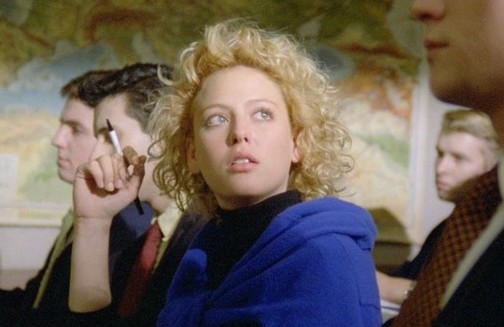
Exorcist II: The Heretic – 1977, US, 117m. Director: John Boorman.
Nightlife – 1989, US, 92m. Director: Daniel Taplitz.
The Tomb – 1986, US, 84m. Director: Fred Olen Ray.

EXORCIST II: THE HERETIC (1977) A disillusioned priest (Richard Burton) is sent by the Church to look into the circumstances surrounding Father Merrin’s (Max von Sydow) death at the end of The Exorcist. Burton’s investigation brings him to 16-year-old Regan (Linda Blair) who, still feeling the effects of her possession from the first movie, is attending a special clinic run by Ellen Burstyn lookalike Louise Fletcher—Burstyn didn’t reprise her role as Regan’s mother, making her the smartest person not to be featured in this bloated sequel. Burton travels to Africa to meet with a man (James Earl Jones) who survived an adolescent possession by the demon Pazuzu, and where the viewer is forced to watch excruciatingly dull scenes of Burton sleepwalking through his role. Burton becomes consumed with the case and brings Regan to her old house in Georgetown to confront Pazuzu in a preposterous ending that gives new meaning to unintentional comedy. It seems a difficult task for director John Boorman (Deliverance) to flesh out the same characters and situations William Friedkin handled so effortlessly in the first film—too many of them come off as cold and calculating, including Fletcher’s psychiatrist who, even after witnessing supernatural events, continues to be a Doubting Thomas to Regan’s demonic plight. Blair is wasted in a role which (unlike its predecessor) feels one dimensional. D

NIGHTLIFE (1989) Before he was cast as vampire Barnabas Collins in the 1991 revival of Dark Shadows, Ben Cross played vampire Vlad in this made-for-TV, Dark Shadowsesque satire. Friendly vamp Angelique (Maryam d’Abo) awakens from a decades-long slumber and begins a relationship with blood specialist David (Keith Szarabajka), who supplies her with endless bags of donor blood to feed off. Angelique’s old flame, Vlad, discovers her return and makes it his mission to get her back—despite the fact she buried herself in the ground for 100 years just to get away from the creep. Vlad sends two bumbling vampire goons after Angelique, but she and David get away and end up making love in her penthouse coffin (“You call this a bed?”). A lack of fresh blood gives Angelique a skin disorder that has her fleeing into hiding until Vlad traps and brings her to his lair. In an effort to save Angelique, David captures one of Vlad’s cronies in his lab and uses ultraviolet lights on the vamp where it explodes at the feet of a janitor who, in the movie’s funniest scene, states, “I’m not cleaning that up!” Unfortunately, Nightlife doesn’t supply audiences with enough comically charged moments to recommend viewing, although Cross and the gang try to make the most of the situation. It’s unfortunate the script doesn’t return the favor. C

THE TOMB (1986) The unstoppable Fred Olen Ray strikes again with this half-baked rip-off of Bram Stoker’s Jewel of the Seven Stars. Macho tomb raiders awaken Egyptian vampire Nefratis (Michelle Bauer) when pilfering her unmarked mausoleum. The sole survivor (David O’Hara) escapes to America, along with an artifact from the tomb, only to be followed by the vampiric pharaoh herself, who, in order to retrieve her property, implants a homing device—in the form of a flesh-eating scarab—inside O’Hara’s chest. Nefratis wastes no time killing the various men who stand in her way of obtaining the precious relic, including a collector whose heart she rips out. When Nefratis feels the need to feed, she picks up a lesbian at a bar only to toss her into a bed of giant snakes for no particular reason. Ray’s direction might lack substance but there’s no denying The Tomb is pumped with a good amount of energy, even when it’s not always working. It helps that the movie never takes itself seriously and is often quite funny, especially a scene where a U.S. customs agent, in an attempt to arrest Nefratis, is obliterated by a flash of light from her hand. Scream Queen Sybil Danning might get top billing, but her participation is all but a few minutes of screen time. It ain’t very good, but a likable cast and a sense of enjoyment make The Tomb a watchable 80 minutes. B–
Check Just Watch for current streaming info!





































